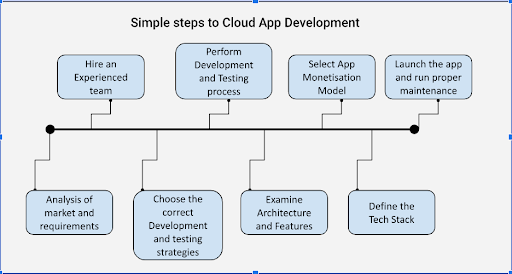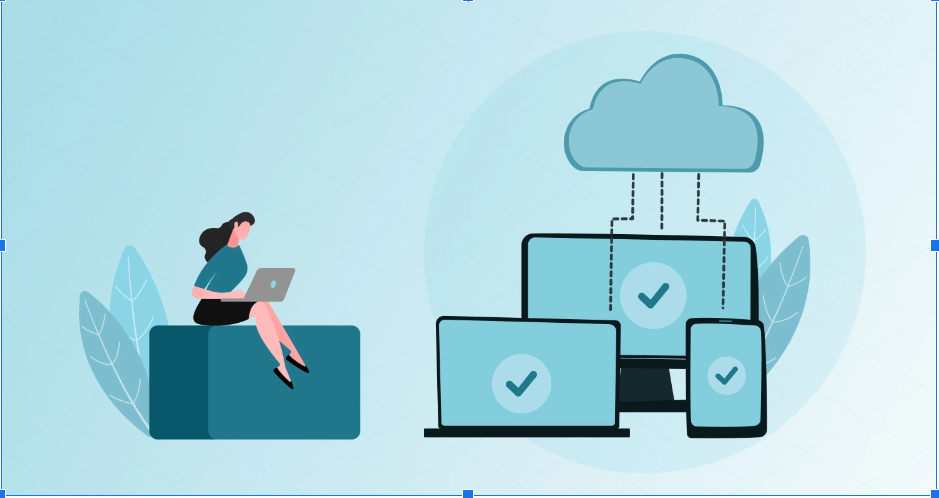Cloud Applications: A Step-By-Step Development Process
The cloud app development process brings a lot of convenience to modern businesses. It helps manage storage and performance issues to improve the end-user experience.
Join the DZone community and get the full member experience.
Join For FreeThe cloud app development process brings a lot of convenience to modern businesses. It helps manage storage and performance issues to improve the end-user experience. The cloud app development process includes a series of steps described in the points below.

1. Analyze the Market
The cloud app development market has been ever-evolving—new trends and technologies in the market shape app development. Certain things like the presence of major cloud providers, the use of containerization, and Kubernetes help businesses achieve consistency across development and testing processes.
2. Hire an Experienced Team
Hiring the right people for your cloud app development project can take time and effort. You must understand the basics of hiring the right developers, look into their experience and communication ability, and clarify your project’s requirements. Planning a budget and looking into the hidden costs is also essential.
3. Choose the Correct Development and Testing Strategies
Proper development and testing strategies in cloud app development can help build and deploy efficient applications. You can consider agile practices to establish flexibility, and automated testing techniques help bring cost-effectiveness by reducing the time needed to complete this process. Some more practices like adapting continuous improvement help the teams stay updated, and implementing CI/CD automates the integration.
4. Define the Tech Stack
Different projects use specific technical stacks depending on the project's requirements. The developing team can select programming languages, frontend frameworks, backend frameworks, databases, APIs, cloud computing platforms, and more from the various available options. Before starting the project, the developer's team should define cloud services, authentication and authorization methods, DevOps tools, monitoring and logging, and security measurement strategies.
5. Developing and Testing
A thorough development and testing process involves the following:
- Comprehensive requirement analysis.
- Configuring the development and testing environment.
- Integrating CI/CD into the development pipeline to ensure simplified integration.
- Integrating security practices and performing security and vulnerability testing is essential to secure the app.
6.Examine the Architecture and Features
The cloud app development architecture has to deal with the building process, deployment, and scaling operations. It should support those actions efficiently. Examine if resources can be added easily and the performance of the existing resources can be improved without any hassle. Also, examine the microservices architecture, containerization technologies, serverless computing capabilities, data storage options, and more.
7.Select the App Monetization Model
Selecting a monetization model for cloud app development helps examine how the app will generate revenue. You can choose a subscription model like Netflix adopted, a freemium like Dropbox, a pay-per-use like how the cloud storage service providers use, or an ad-based model.
8. Launch the App and Run Proper Maintenance
Several steps are involved in launching the cloud app and running its proper maintenance. This includes infrastructure provisioning, implementing deployment strategies, setting up comprehensive monitoring and logging tools, configuring auto-scaling and more practices.
What Are the Benefits of Selecting Cloud App Development?

1.Flexibility
Cloud app development organizations offer a lot of flexibility regarding ease of scaling applications and several resources like computing power, storage, and more.
2. Cost Efficiency
Cloud app development services eliminate the need for infrastructural costs and allow businesses to choose from different payment models. Companies can opt for a pay-as-you-go model and benefit from reduced capital expenses. Easy disaster recovery Cloud app development services render data redundancy and replication, which allow automated backup facilities and leverage efficient virtualization.
3.Time-Saving
Cloud app development services save a lot of time and resources usually used in app development. It features rapid growth, automated updates and maintenance, pre-built services and components, and more.
4.Improved Deployment
Cloud app development services can significantly improve the deployment process using automated deployment and other features like IaC, CI/CD, several scalable resources, and more.
5.Global Accessibility
The services offer content delivery networks (CDNs), and graphic distribution channels, support global load balancing, and cross-region redundancy and foster collaboration among teams located in different regions.
6.Data Analytics and ML
The services have powerful data analytics and machine learning functionalities that offer scalable computing power. Along with the mentioned advantage, it offers pre-built ML services and APIs, robust data storage and management, and support for popular ML frameworks.
Strategies Opted by Successful Cloud Companies for Developing Cloud App Development
Successful cloud companies often employ a range of strategies to develop and maintain their cloud applications effectively. These strategies are designed to optimize the development process, ensure high-quality products, and maintain a competitive edge in the market. Here are some common strategies adopted by successful cloud companies:
1.Adoption of Agile Development
Agile methodologies work hand-in-hand with cloud app development services. Using iterative development cycles and frameworks like Scrum or Kanban help apply agile methodologies in cloud app development. Agile methods embrace changes in the project’s requirements and our teams implement CI/CD pipelines to automate the testing and deployment processes.
2.DevOps Integration
DevOps integration brings a lot of benefits to the cloud app development process. It promotes collaboration between the development and testing teams, helps the organization make faster releases, reduces integration issues, and allows early identification of problems.
3.Microservices Architecture
Companies use microservices architecture because it offers scalability, modularity, and flexibility. It encourages autonomous development and deployment, which helps accelerate the development cycle and enables continuous delivery practices. Such an architecture also supports using different languages and technologies to render flexibility.
4.Serverless Computing
Serverless computing simplifies infrastructure management, enhancing scalability and improving cost efficiency. Such computing helps the developers focus on application logic without managing the server provisioning, maintenance, or scaling functionalities. Some other benefits include: Reduced operational overheads, Automatic scaling, Faster time-to-market.
5.Containerization and Kubernetes
These are widely adopted technologies that ensure consistent behavior across software development. Containerisation also provides practical portability, rapid deployment and more. On the other hand, Kubernetes supports automatic scaling, high availability, self-discovery, and long balancing, among other things.
6.CI/CD
Integrating CI/CD into the software development process can render several benefits. The benefits include automated testing, early detection of issues, quick feedback, consistent builds and more.
7.Security by Design
Establishing this strategy helps us proactively address existing and potential security concerns. There are several ways of implementing security by design. These include threat modeling, identity and threat management (IAM), and data encryption.
8. Multi-Cloud and Hybrid Cloud Strategies
Leveraging resources from multiple cloud solutions offers increased flexibility and optimization of resources. Ways that have helped us in implementing this strategy include understanding your business requirements thoroughly, establishing governance policies, defining the workload placement, and implementing cloud-native services.
9.AI and ML Integration
Cloud Companies uses this strategy to improve the application’s capabilities and improve the user experience. Companies uses steps like clearly defining the business objectives, ensuring high-quality data collection, implementing data privacy regulations, selecting appropriate AI/ML models and more.
10.Low-Code and No-Code Development
Utilizing this strategy, Cloud companies effectively minimize the traditional coding efforts. Low code development does include some complex parts of the coding processes but helps developers develop visual interfaces and pre-built components faster. No code, on the other hand, requires no traditional coding skill or expertise. The technique uses drag-and-drop interfaces and pre-built templates to speed up development.
11. Customer-Centric Development
Using this approach fulfills customer needs while delivering an enhanced user experience. Adapting an iterative design process, conducting thorough research, creating detailed user personas, and defining the user stories effectively are some ways that help us achieve this kind of development.
12.Compliance and Governance
It is one of the essential strategies that app-developing businesses should adhere to maintain security and operational controls.
Opinions expressed by DZone contributors are their own.

Comments